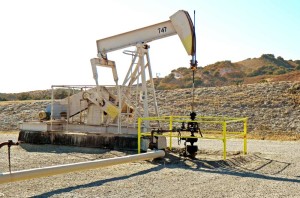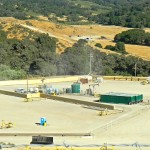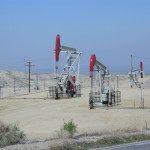
21
Jan, 2016
There Will Be Diatomaceous!
Republished from Mission and State, an investigative journalism project funded by a generous grant from the Knight Foundation.
Bob Poole offers a warm hello and ushers his guests into an unexpectedly artsy office building on Airpark Drive near the Santa Maria airport. With his wide smile, gray beard, lightly sunburned face and peach-colored Hawaiian shirt, Poole looks more like a guy getting ready for a Friday night in Margaritaville than an oil exec about to host a tour of his company’s state-of-the-art oil field.
 Oil booms come with a wooing ritual, and as the public and government affairs manager for Santa Maria Energy, it’s Poole’s job to put a sexy, eco-friendly face on the company’s plans to drill 136 new wells at its Careaga oil field in Orcutt.
Oil booms come with a wooing ritual, and as the public and government affairs manager for Santa Maria Energy, it’s Poole’s job to put a sexy, eco-friendly face on the company’s plans to drill 136 new wells at its Careaga oil field in Orcutt.
This project and its subsequent Environmental Impact Report have been under review by the Santa Barbara County Planning Commission since 2011. However, Santa Maria Energy’s expansion plans face challenges from environmental groups and a state law limiting emissions. In a worst-case scenario, the Careaga field expansion could generate 87,874 metric tons of emissions at peak production. If left unchecked, say environmentalists, the Careaga field expansion could become one of the biggest greenhouse-gas producers in Santa Barbara County history.
The state, though, under the California Global Warming Solutions Act (AB 32), a 2006 law restricting emissions and mandating public scrutiny of new oil drilling, is calling for a 16 percent emissions reduction before it green-lights the project. Santa Maria Energy is offering a 29 percent reduction. Local environmental groups such as the Environmental Defense Center and Santa Barbara County Action Network, however, demand that the greenhouse gases be cut by 90 percent. More recently, the planning commission suggested a compromise of a 50 percent reduction, but so far no one’s budging.
Which brings us to Poole in his Hawaiian-shirt splendor. In a play for the hearts and minds of oil-averse Santa Barbara, Santa Maria Energy has opened its Careaga oil field to public inspection. Lately, Poole’s been busy taking politicians, journalists and civilians there.
The first tour stop is a brightly colored conference room in which awaits David Pratt, the company’s president. Pratt is the first Santa Maria Energy employee who doesn’t look like he just came from the farmers market. He speaks confidently, and with his feet up on the table. A proud Texan from Houston, Pratt likes oil and doesn’t like Oklahoma or the EDC.
“Some law firms make money. These nonprofit law firms are in it to stop people from doing business,” explains Poole.
Pratt puts us through a perfunctory grilling about our affiliations and intentions before sending us along with a firm Texas handshake.
Helping Poole with tour-guide duties is Ashley Costa, a woman whose LinkedIn network would seem to weave a tangled web. Costa is on the board of the Santa Barbara County Air Pollution Control District, which regulates oil and other industries’ emissions. She’s also the youngest city councilmember in Lompoc, home of the Loring Wine Company, where Costa can be seen pouring Pinot Noir on weekends.
Her day job is doing PR for Santa Maria Energy. Costa has already appointed a co-worker, Laurie Tamura, to the Air Pollution Control District’s community advisory board. If any of these many hats appear to clash, the 26-year-old Costa isn’t letting on.
“Santa Barbara County has the most stringent oil company regulations in the world,” she says. All-in-one regulator and booster—this is oil politics, Santa Barbara County style.
For his part, before Poole became Santa Maria Energy’s main flack, he worked for the Solvang and Goleta Chambers of Commerce, and was one of the orchestrators of Goleta’s cityhood. He also did a stint with the Western States Petroleum Association.
Santa Maria Energy is serious about its public relations. While some of Poole’s industry peers work out of garage offices or living rooms, he has a big, windowed office at a headquarters equipped with a rock-star-grade cafeteria that boasts a two-lane bowling alley behind the bar. Exposed ceiling beams and movie posters line the airy dining room. The building also comes with a stadium-seating screening room, which happens when your office space used to belong to a special-effects film company.
When the office tour is complete, we load into cars and head south on Highway 135 toward the Orcutt Hills, just north of Los Alamos. We pass through acres of White Hill grapes. Vineyards and oil fields are often neighbors in these parts. Costa says the grapes we see might be Pinot and Chardonnay. At White Hills Vineyard, the convoy takes a dirt road until the lush green abruptly gives way to a lifeless, bland landscape of sand and steel—but surprisingly clean sand and steel. We have arrived at the Careaga oil field’s steam-injection well pad: a massive two-level facility with drills, water trucks, steam pipes and everything you need to get heavy oil from the ground.
The oil pad’s newly painted pipes beam in the sun. The ground is clean. The drills are new. From a distance they could almost pass as water pumps—innocuous compared to the two-story-high nodding donkey pumps. It’s clear upon seeing the new well pad that this is no Greka Oil and Gas. Greka’s rusted, old facility near the vine-lined Telephone Road in Santa Maria harkens back to another era in oil. Whereas local, state and federal agencies regularly bust Greka for environmental infractions, Santa Maria Energy has won Outstanding Lease Maintenance awards two years in a row.
The well pad we’re touring houses equipment that will heat the ground to more than 550 degrees to extract black, thick-as-molasses diatomaceous oil. Diatomaceous is dead algae that after millions of years turned into oil rock. For those familiar with Santa Barbara County beaches, beige-colored diatomaceous rock makes up the cliffs cradling the coastline. Here, it is 1,000 feet below us, black and oozes with thick, heavy oil once it’s heated.
“It’s the other oil boom,” he says of the diatomaceous drilling going on at the site.
Poole drives us to the tidy trailer parked at the edge of the well pad, filled with computers monitoring the wells. It’s not the industry standard for oil companies to offer such close-ups of how the sausage gets made. When I asked Vintage Petroleum about its heavy-oil project in Ventura County, a representative dismissed the question with a curt, “We don’t talk about our operations.”
Poole explains that the Santa Maria Valley also sits on the oil-rich geographical formation called the Monterey Shale. Geologists have known about the Monterey Shale “play” for decades. The problem had always been how to get the deep-in-the-ground oil out of the stubborn rock. Fracking, currently bringing oil booms to small towns in the Dakotas and elsewhere, is the answer in other parts of the country. Santa Barbara, however, approved strict permit processes in 2011 that all but ban the practice after the county discovered Venoco Inc. fracking two North County leases on the sly.
Santa Maria Energy’s focus on expanding diatomaceous drilling is partly to make up for the difficulty of getting to the Monterey Shale without fracking. Not that they’re forsaking the shale. Poole explains that it’s already been “naturally fracked” by active fault lines and those nodding pumps are extracting shale oil with the help of chemical injections shot through “reworked” wells.
We drive over to a second hill where three huge water trucks are parked side by side, pumping steam through pipes 1,000 feet into the ground to loosen up the heavy diatomaceous oil for extraction. Our next destination is the old ghost town of Bicknell. Built quickly during the gold rush, the remnants warn visitors of what happens when a town gets too optimistic and then burned by oil prospects. Poole shows us an old black-and-white photo of the proud town standing over its just-built municipal pool. There are hollows in the ground that were once the foundation beds for the long-gone houses that once belonged to Shell workers. A giant wooden pump straight out of There Will Be Blood looms nearby.
The tour ends with Poole driving us to the top of a hill overlooking the valley. He says spotting wells through the trees and grapevines is like “looking for Waldo.” But spotting the wells dotting the valley like barely hidden eggs on Easter doesn’t tell you much, like whether the groundwater is contaminated, or if the chemicals pumped into the wells are rising to the surface, or if an earthquake fault is getting irritated by steam and water injections, or when the last time the pipes were cleaned. All the real action happens underground or out of sight.
Might have to dig a little deeper.
Originally published in Mission and State and funded by a generous grant from the Knight Foundation






You must be logged in to post a comment.